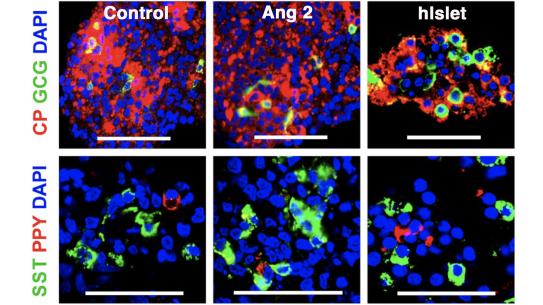Regenerating Human Islets from iPSCs

Speaker:
Kaiming Ye, PhD
Professor and Chair
Department of Biomedical Engineering, SUNY Binghamton
Abstract:
Creation of highly organized multicellular constructs, including tissues and organoids, has the potential to revolutionize tissue engineering and regenerative medicine. The development of these technologies will enable the production of individualized organs for patient-tailored organ transplantation or individualized tissues for cell-based therapy. Dr. Ye’s team is developing technologies for generating physiologically functional tissue organoids from human pluripotent stem cells (HPSCs). For example, they biofabricated human islets from iPSCs. These organoids exhibited a tissue architecture similar to human pancreatic islets, consisting of pancreatic α, β, δ, and pancreatic polypeptide (PP) cells. His group discovered that tissue scaffolding and inspirting are critical to the generation of pancreatic endoderm and the assembly of islet architectures. The organoids formed consisted of a high-level co-expression of PDX1, NKX6.1, and NGN3. More importantly, most insulin-secreting cells generated did not express glucagon, somatostatin, or PP. The expression of mature β cell marker genes such as Pdx1, Ngn3, Insulin, MafA, and Glut2 was detected in generated islet organoids. Exposing the organoids to a high concentration of glucose induced a sharp increase in insulin secretion, whereas glucagon is released when they are exposed to a low glucsoe, indicating the glucose-responsive insulin release and glucagon secretion, a characteristic physiological metabolism of the human islets.
Before becoming the Chair of the biomedical engineering department at SUNY Binghamton in 2014, Professor Ye held various academic and non-academic positions. This includes professorships at the University of Arkansas and the University of Pittsburgh and research appointments at the Kyushu Institute of Technology and Kyoto University, both in Japan. In addition, he served as the Biomedical-Engineering-Program Director at the National Science Foundation (NSF). He is an elected Fellow of the American Institute for Medical and Biological Engineering (AIMBE) and Senior Member of the IEEE. His research has been continuously supported by NSF, NIH, JDRF, ABI, and various companies. Furthermore, he has chaired a large number of national international conferences.


